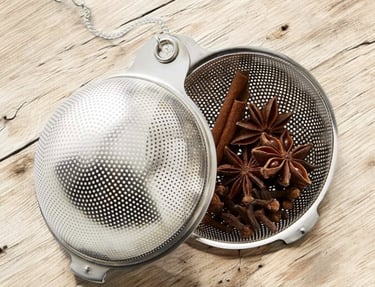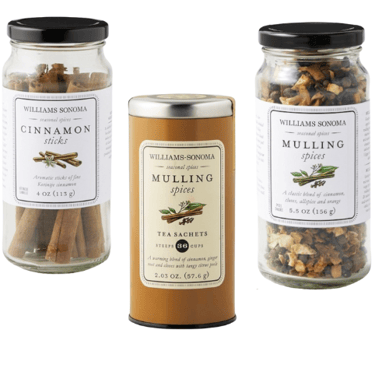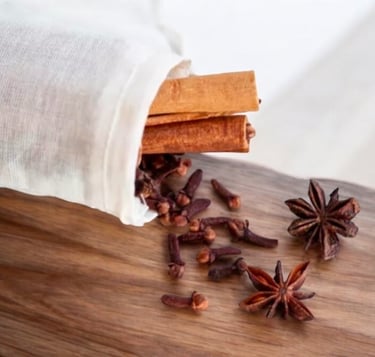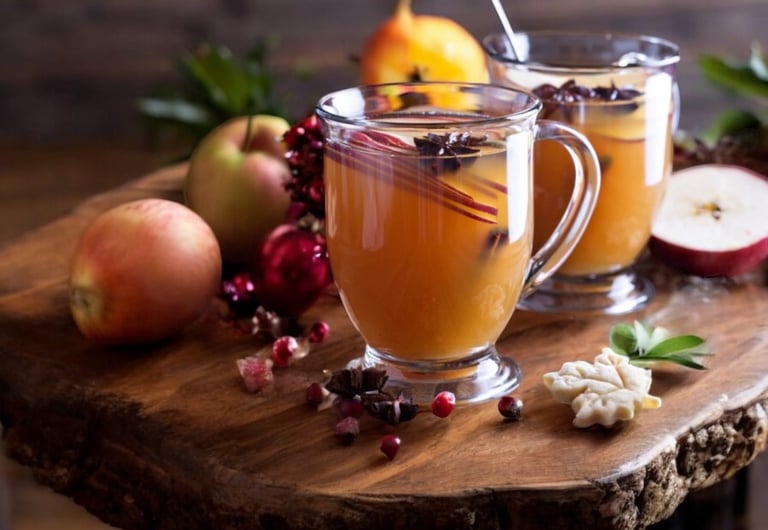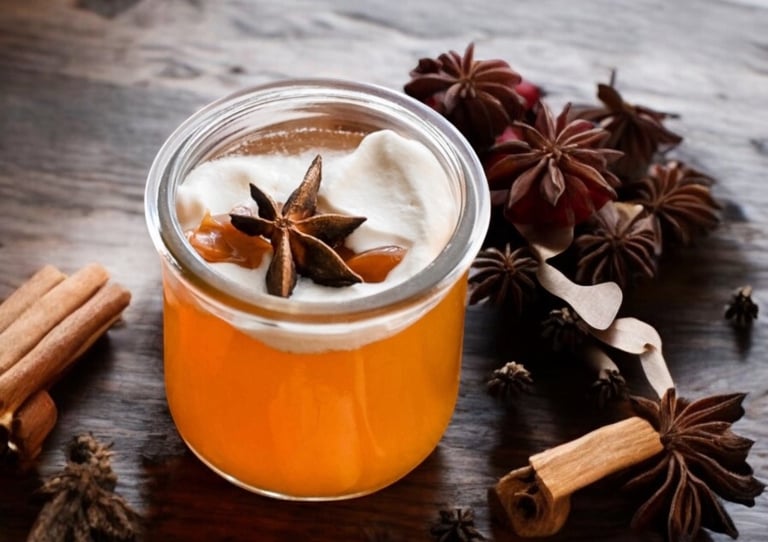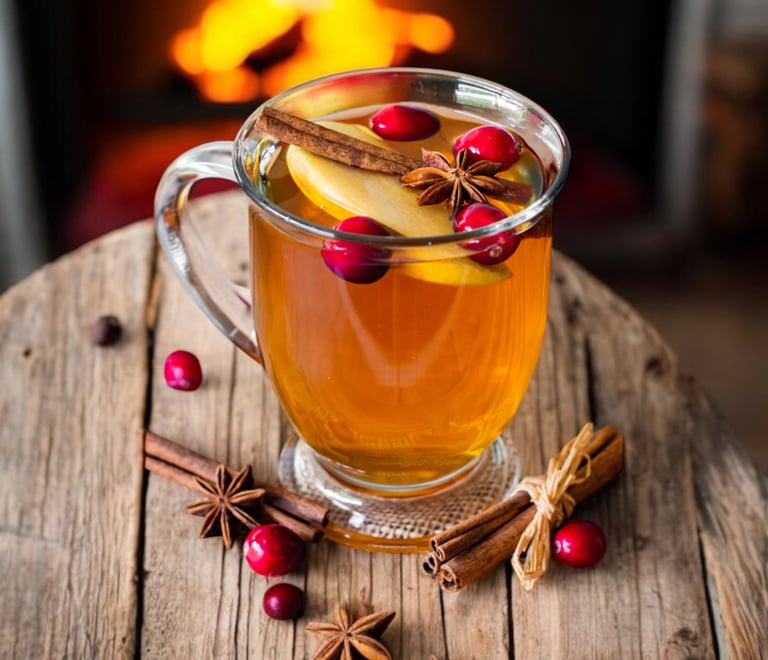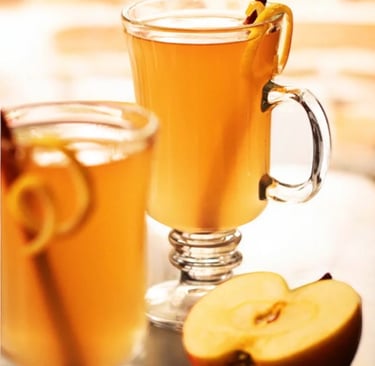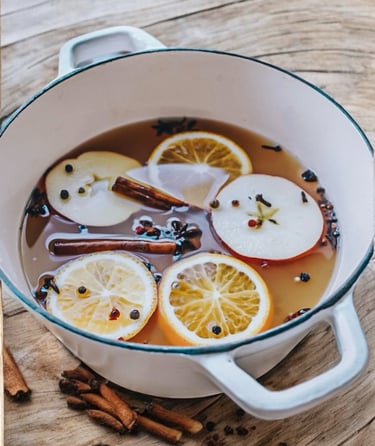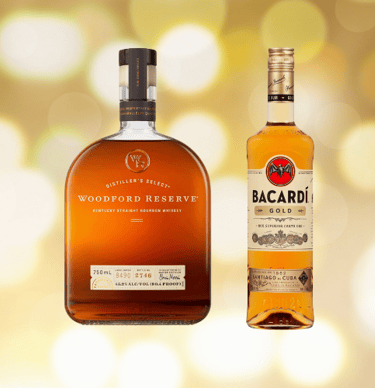The Cozy Comfort of Warm Spiced Apple Cider
There's something undeniably comforting about a mug of warm spiced apple cider on a crisp autumn or winter evening. The sweet, slightly tart flavor and the fragrant, warm steam rising to meet your face awaken the senses—it's the quintessential fall experience. But warm apple cider is more than just a seasonal treat; it's a versatile beverage with a rich history and surprising adaptability.
INSPIRATIONAL DRINKS
1/3/20255 min read
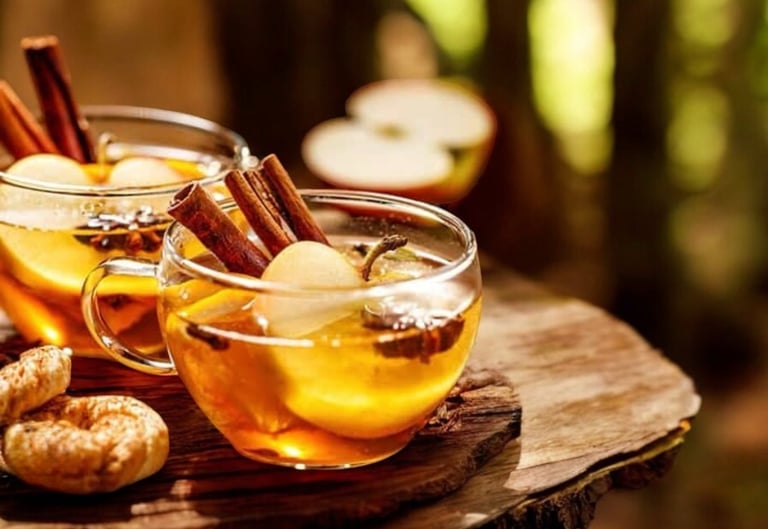

A Sip Through History
Apple cider's origins trace back centuries, with evidence suggesting its production in ancient times. While the exact details are fuzzy, we know that apples have been cultivated for thousands of years, and the process of pressing apples for their juice is relatively straightforward. Over time, the tradition of warming cider, adding spices, and sharing it during cooler months evolved into the comforting ritual we enjoy today.
Beyond the Basic Brew
While a simple, warmed cider is delicious on its own, there are countless ways to elevate this classic beverage.
Spiced Cider: The classic addition of cinnamon sticks, cloves, star anise, and allspice transforms a simple cider into a fragrant, warming delight. Experiment with different spice combinations to find your perfect blend. A splash of vanilla extract can also add depth and complexity.
Mulled Cider: Similar to spiced cider, mulled cider often involves simmering the cider with spices for an extended period, allowing the flavors to meld and deepen. This process creates a richer, more intense flavor profile.
Apple Cider Sangria: For a more sophisticated twist, consider adding your favorite spirits, such as rum, brandy, or bourbon, along with some orange slices and mixed berries. This creates a festive and flavorful adult beverage, perfect for gatherings.
"Brandy"
I recommend a brandy that's fruity and not overly oaky or spicy, as you don't want it to overpower the apple cider's delicate flavors. A good quality VSOP Cognac or a lighter Armagnac would work well. Avoid very dark or heavily oaked brandies.
A small amount will add depth and warmth without overwhelming the other flavors.
"Bourbon"
You want a bourbon that won't overpower the delicate flavors of the apples and spices. Avoid heavily oaked or high-proof bourbons; instead, choose something smoother and more subtly flavored.
Lower Proof a bourbon with a proof in the 80-90 range will be less likely to overpower the cider. Higher proof bourbons can be harsh and burn the palate.
Wheat or Rye Bourbons these styles often have a softer, sweeter profile compared to standard bourbon, which is typically made with corn. The smoother notes of wheat or rye will blend more harmoniously with the apple and spice flavors.
Bourbons with notes of caramel, vanilla, or honey these flavor profiles will complement the sweetness of the apple cider and create a more balanced and enjoyable drink.
Avoid bourbons with intense notes of oak or char, as they can be too assertive and will clash with the apple cider and spices. Start with a small amount and add more to taste; a little goes a long way! The goal is to enhance, not overpower, the overall flavor profile.
"Rum"
You want a rum that complements the apple and spice notes without overpowering them. Avoid dark, heavy rums with strong molasses or oak flavors. Instead.
Light or Gold Rum a more subtle flavor profile that won't clash with the cider's sweetness and spices. They'll add a nice warmth and a hint of sweetness without being overpowering. Look for ones with notes of vanilla or caramel for a better complement.
Spiced Rum while a spiced rum might seem like an obvious choice, proceed with caution. The pre-existing spices in the rum could clash with your chosen spice blend for the cider. If you use a spiced rum, start with a very small amount and taste as you go to avoid an overwhelming spice profile.
The best rum will depend on your personal preference and the specific spices you're using in your cider. Experiment to find your perfect combination! Start with a small amount of rum and add more to taste, ensuring the rum enhances the cider's flavor rather than dominating it.
Non-Alcoholic Variations: For those avoiding alcohol, consider adding a splash of cranberry juice for a tart kick, or a squeeze of fresh lemon for brightness. A touch of maple syrup can enhance the sweetness without being overpowering.
Making Your Own
Making warm apple cider at home is surprisingly easy. Simply heat your favorite cider (freshly pressed is best, but store-bought works well too) gently on the stovetop (cast iron pot) or in a slow cooker. Add your chosen spices during the warming process. Be careful not to boil the cider, as this can diminish its flavor and aroma. For a consistently delicious result, I recommend William Sonoma's pre-blended spice mix and sachet; it provides just the right amount of flavor and best of all convenience.
Beyond the Mug
Warm apple cider isn't confined to mugs. Consider incorporating it into other recipes.
Spiced Apple Cider Glazes: Use spiced apple cider as a base for glazes for roasted meats or vegetables.
Spiced Apple Cider Cakes and Breads: The moistening and flavoring properties of apple cider make it a fantastic addition to baked goods.
Whether you're enjoying a simple mug of warm cider on a chilly evening or using it as a key ingredient in your next culinary creation, the versatility and comforting nature of this autumn and winter beverage make it a true classic. So, grab a mug, add your favorite spices, and savor the warmth and comfort of a spice apple cider!
